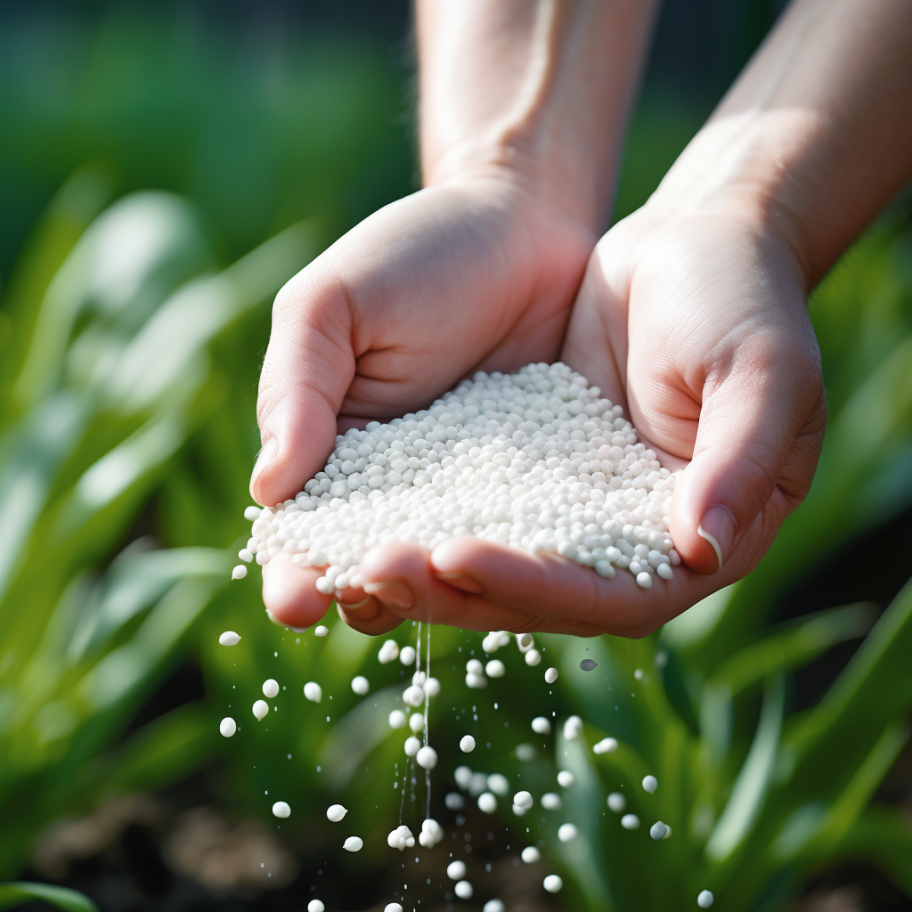Ammonium nitrate is a common nitrogen-based fertilizer that contains both ammonium and nitrate ions. These ions play essential roles in the physiological processes of plants. When used properly, ammonium nitrate can provide several benefits to plants. This comprehensive article explores all aspects of using ammonium nitrate as an effective fertilizer.
What is Ammonium Nitrate?
Ammonium nitrate is a white, crystalline chemical compound with the chemical formula NH4NO3. It forms when ammonia gas is reacted with nitric acid to produce a concentrated version of the compound.
Some key facts about ammonium nitrate:
- Provides a vital source of nitrogen for plant growth
- Typically contains 33-35% nitrogen content
- Highly soluble and fast acting as a fertilizer
- Available in granular and liquid formulations
- Classified as an oxidizer due to supporting combustion
- Requires careful handling, storage and transportation
Ammonium nitrate has served as an important fertilizer for decades, allowing farmers and gardeners to provide their plants with ample nitrogen for healthy development. However, it also has some potentially hazardous properties if mishandled.
How is Ammonium Nitrate Produced?
The production process for ammonium nitrate involves a chemical reaction between ammonia and nitric acid. Here are the key steps:
- Ammonia production – Anhydrous ammonia gas is produced from nitrogen and hydrogen under high pressures. This provides the ammonia source.
- Nitric acid production – Strong nitric acid is produced by reacting ammonia with oxygen and water. This provides the nitric acid source.
- Reaction – The ammonia gas and nitric acid are combined in a reaction vessel, producing ammonium nitrate in concentrated aqueous solution.
- Prilling – The solution is concentrated and converted into small beads or prills through specialized prilling towers. This gives the characteristic tiny, round granule shape.
- Additives – Anti-caking compounds like clay or limestone are added to prevent clumping.
- Coating – The prills may be coated with wax or polymers to control absorption of moisture and improve flowability.
- Packaging – The finished ammonium nitrate prills are then packaged into bags, totes or bulk containers for distribution.
The end result is a highly concentrated, stable source of nitrogen in the form of ammonium nitrate prills or beads. The prilled format prevents breakdown, caking and provides controlled nutrient release.

Chemical Properties
Ammonium nitrate has some key chemical properties that influence its behavior and use as a fertilizer:
- Solubility – Readily dissolves in water, allowing nitrogen to be available for plant uptake when applied as a fertilizer.
- Acidity – When dissolved, it creates an acidic solution ideal for neutralizing alkaline soils.
- Oxidizing – Supports the combustion of organic material, which makes it useful for explosives but also requires careful handling.
- Hygroscopicity – Ability to absorb moisture from the air can lead to caking if left uncontrolled. Hence the need for anti-caking agents.
- Nitrification – Gradually converts to nitrate, providing both quick and longer-term nitrogen availability.
These traits make ammonium nitrate a highly effective source of nitrogen nutrition for plants. But they also mean it requires responsible use and management to prevent potential hazards.
Benefits of Using Ammonium Nitrate Fertilizer
When applied properly, ammonium nitrate can provide a range of benefits as a fertilizer for plants and crops. Here are some of the top advantages:
Boosts Nitrogen Levels in Soil
With a nitrogen content of 33-35%, ammonium nitrate is an excellent source of this essential plant nutrient. Nitrogen is required by plants for important processes like:
- Leaf and stem growth
- Photosynthesis
- Protein and enzyme production
- Chlorophyll synthesis
- Nucleic acid formation
Applying ammonium nitrate fertilizer replenishes the soil with a readily plant-accessible form of nitrogen. This ensures optimal nitrogen supply for productive plant growth.
Promotes Overall Growth and Development
In addition to fueling vital physiological processes, the nitrogen provided by ammonium nitrate enhances the overall growth and development of plants.
With sufficient nitrogen availability, plants exhibit:
- Lush, green vegetative growth
- Fast establishment of young plants and seedlings
- Effective responses to pruning and training
- Abundant flowering and fruit production
- Increased plant vigor and yield potential
The boost in available nitrogen enables plants to reach their full genetic potential in terms of productivity and quality.
Enhances Nutrient Uptake Efficiency
Ammonium nitrate also enhances the ability of plants to take up other important nutrients like phosphorus, potassium and micronutrients.
It achieves this by:
- Improving root growth and surface area for absorption
- Increasing permeability of root cell membranes
- Boosting nutrient mobility in the soil
- Acidifying the soil to increase nutrient availability
Plants supplied with adequate nitrogen are better able to access and utilize soil resources. This improves the efficiency of fertilizer applications.
Provides Rapid Nutrient Availability
Unlike some slower-release forms of nitrogen, the nitrogen in ammonium nitrate is quickly available for plant uptake after application.
The ammonium portion of the molecule can be directly absorbed by plants soon after coming into contact with soil moisture.
The nitrate portion gradually converts to an absorbable form through natural soil processes. This provides both an immediate and longer-term nitrogen supply.
The rapid nutrient availability makes ammonium nitrate ideal for fast-growing crops with high nitrogen demand, or for giving young plants a boost.
Improves Soil Structure and Fertility
In addition to its nutritional contribution, ammonium nitrate can enhance some of the physical and chemical characteristics of soil.
It does this by:
- Acidifying soil pH – Better for some crops and aids nutrient release
- Improving drainage and aeration – Via improved organic matter decomposition
- Increasing microbial activity – More nitrogen-fixing and nutrient cycling
- Reducing sodium content in soils – Replaces sodium ions on clay particles
Over time, ammonium nitrate fertilization can gradually improve soil quality and fertility.
Versatile Use for Many Crops
Ammonium nitrate is suitable for fertilizing a broad spectrum of plant species and cropping systems.
It can be effectively used for:
- Cereal grains – wheat, rice, barley, etc.
- Vegetables and fruiting crops
- Tree fruits, vines and berries
- Ornamental flowers and shrubs
- Turf grass
- Forage crops like corn, sorghum and hay
The wide adaptability makes ammonium nitrate a versatile foundation for fertilizer programs across agricultural, horticultural and hobby garden settings.
Cost-Effectiveness
On a pound-for-pound basis, ammonium nitrate is typically one of the most affordable and economical nitrogen fertilizers.
Factors that contribute to the cost-effectiveness:
- Simple manufacturing process
- High concentration of nitrogen per unit
- Lower transportation costs than some alternatives
- Wide availability through major fertilizer suppliers
The relatively low cost coupled with the proven effectiveness makes ammonium nitrate an attractive choice for many fertilizer applications.
By understanding the myriad benefits ammonium nitrate provides as a nitrogen source, it’s easy to see why it has been trusted by farmers and growers for decades.
How to Use Ammonium Nitrate Fertilizer on Plants

To fully realize the benefits of ammonium nitrate, it’s important to follow sound agronomic practices and stewardship principles when applying it as a fertilizer. Here are some key guidelines:
Soil Testing
Soil testing provides critical information about current nutrient levels that allows customizing fertilizer applications. Key test parameters include:
- pH
- Organic matter
- Major nutrients – N, P, K
- Micronutrients
- Cation exchange capacity
This data helps determine optimal ammonium nitrate rates and whether other nutrients need to be supplemented.
Annual soil testing is recommended to monitor soil changes over time.
Recommended Application Rates
Application rates should be based on:
- Soil test recommendations – Avoid over or under-application based on measured soil nutrient levels.
- Crop nitrogen requirements – Rate needed changes between crop types and growth stages.
- Yield goals – Higher expected yields warrant more nitrogen.
- Environmental conditions – Wet, compacted or cold soils may necessitate split applications.
As a general guideline, application rates may range from:
- 100-200 lbs/acre for many grain crops
- Up to 300 lbs/acre for high-nitrogen crops like corn
- 1-2 lbs per fruit tree
- 1 lb per 1000 sq ft of lawn
Always follow specific recommendations from qualified agronomists.
Application Timing and Methods
Ammonium nitrate is often applied using:
- Pre-plant – Incorporated into soil prior to planting
- Sidedress – Banded into soil near the crop row after emergence
- Foliar sprays – Applied directly on leaves, often in solution mixes
- Fertigation – Injected into irrigation water for application
- Controlled-release fertilizers – Ammonium nitrate coated to control nutrient release over time
Splitting the total amount across multiple timings can enhance efficiency. Foliar sprays provide flexibility to address in-season deficiencies.
Application methods must deliver uniform coverage across the treated area. Common tools include:
- Broadcast spreaders
- Row banding and injection equipment
- Irrigation systems – drip, pivot, sprinkler
- Sprayers
Avoid direct contact with seed or roots to prevent injury.
Incorporation into Soil
To prevent nitrogen losses, ammonium nitrate should be incorporated into the soil after surface spreading. This can be achieved by:
- Mechanical tillage using discs, harrows or chisels
- Irrigation or rainfall after application
- Natural processes like earthworm activity
Incorporation places the nitrogen into the crop rooting zone where it is accessible to plants while avoiding losses from volatilization or runoff.
Storage and Handling Precautions
Due to its physical properties, ammonium nitrate requires responsible storage and handling:
- Store in original packaging in a clean, dry, well-ventilated and temperature controlled environment. Avoid excess heat, moisture or contamination.
- Keep away from combustible/flammable materials, heat sources and incompatible chemicals like elemental sulfur.
- Handle carefully using appropriate personal protective equipment to prevent spills or contact with skin and eyes.
- Follow all local regulations for safe storage and transportation of ammonium nitrate. Consult with licensed professionals if needed.
- Store only necessary quantities on-site and avoid carryover by purchasing fertilizer as needed. Use older product first before newly purchased batches.
Adhering to these precautions is imperative for safe ammonium nitrate management.

Ammonium Nitrate Safety Issues and Environmental Impact
While a proven fertilizer, ammonium nitrate does require responsible stewardship to prevent potential safety issues and environmental impacts from improper use or handling.
Safety Risks
Ammonium nitrate does pose some inherent safety risks if mismanaged:
- Explosive hazard – Under certain conditions it can explode, especially when contaminated with incompatible substances. This property requires careful handling and storage protocols.
- Toxic fumes – Burning or thermal decomposition releases toxic oxides of nitrogen and ammonia gases which are hazardous.
- Skin/eye irritation – Direct contact with concentrated ammonium nitrate may cause mild skin, eye or respiratory irritation. Observe good hygiene practices and wear PPE.
- Ingestion – Swallowing ammonium nitrate can cause abdominal pain and vomiting. Seek medical attention.
However, these risks can be effectively mitigated through responsible use practices and stewardship.
Potential Environmental Impacts
Environmental impacts may result from irresponsible practices like:
- Water contamination – Excess nitrogen from spills or uncontrolled runoff degrades water quality, harming aquatic life. Adhere to application rates matched to crop needs.
- Soil acidification – Overuse depletes calcium and contributes to soil acidification over time. Monitor soil pH regularly.
- Nitrous oxide emissions – Over-application can increase nitrous oxide production, a greenhouse gas. Optimize fertilizer rates.
- Nutrient imbalances – Excess nitrogen relative to other nutrients can impair plant growth. Maintain proper balance by soil testing.
- Ozone depletion – Release of nitrogen oxides contribute to atmospheric ozone layer breakdown. Follow safe storage and handling protocols.
Careful management minimizes the likelihood of these impacts occurring.
Responsible Use Practices
Responsible use practices for mitigating risks include:
- Apply only at agronomically recommended rates matched to soil tests and plant requirements
- Use enhanced efficiency fertilizers that control nutrient release
- Implement nutrient management plans for farms
- Store only necessary quantities and avoid carryover
- Follow all local regulations and permitting requirements
- Safely clean any spills immediately
- Recover and reuse bagging and packaging to reduce waste
- Dispose of excess product at designated hazardous waste facilities
With sound stewardship practices, ammonium nitrate can be used safely and sustainably.
FAQs About Using Ammonium Nitrate Fertilizer
What crops can ammonium nitrate fertilizer be used on?
Ammonium nitrate is suitable for a very wide range of crops including cereal grains, corn, vegetables, fruiting crops, vine fruits, tree fruits, ornamental flowers, turfgrass, forage crops like alfalfa, and many more. It is a versatile nitrogen fertilizer for agricultural and horticultural crop production.
What is the recommended application rate?
Recommended rates vary based on factors like soil nutrient levels, specific crops grown, yield targets, and growth stage. General guidelines range from 100-300 lb/acre for field crops, 1-2 lbs per fruit tree, and 1 lb per 1000 sq ft of lawn. Follow rates prescribed from soil test data and qualified agronomists.
How quickly does ammonium nitrate become available to plants?
The nitrogen in ammonium nitrate is very quickly available to plants compared to some extended release fertilizers. The ammonium form can be taken up directly, while the nitrate portion converts rapidly to an accessible form through natural soil processes. This makes it ideal when a fast nitrogen boost is needed.
What temperature should ammonium nitrate be stored at?
Ideally, ammonium nitrate should be stored in a controlled environment between 50-75°F. Excess heat can accelerate breakdown while cold temperatures may lead to clumping. Storing in a stable, moderate temperature environment optimizes shelf life and quality.
How long does ammonium nitrate last when properly stored?
When kept in original packaging in a properly maintained storage environment, ammonium nitrate typically lasts 6 months to 1 year before starting to degrade in quality and lose its explosive hazard. Purchasing only necessary quantities avoids long-term storage. Use oldest product first.
What happens if too much ammonium nitrate is applied?
Over-application of ammonium nitrate can lead to nitrogen losses, soil acidification, excessive vegetative growth, environmental contamination, and increased safety hazards. Adhere closely to recommended rates based on soil analysis and plant requirements to avoid negative impacts.
Are there alternatives or substitutes for ammonium nitrate fertilizer?
There are a number of alternative nitrogen fertilizers, including urea, urea-ammonium nitrate (UAN), ammonium sulfate, calcium nitrate, and organic nitrogen sources. The choice depends on crop needs, soil conditions, cost, and other factors. Consult a qualified agronomist for recommendations.
How do you properly dispose of extra ammonium nitrate?
Check for local hazardous waste disposal regulations. In general, excess ammonium nitrate should be disposed of at designated hazardous waste management facilities and never dumped into the environment. Safely transport and handle any waste product containing ammonium nitrate.
What precautions are needed when handling ammonium nitrate?
Key precautions include avoiding all ignition sources or combustible materials, wearing protective equipment to prevent contact with skin/eyes, following safe storage protocols, avoiding spills or contamination, carefully cleaning any spilled product, and adhering to all local regulations for transporting or using ammonium nitrate fertilizer.
Final Thoughts on Ammonium Nitrate for Soil
When used responsibly, ammonium nitrate can be an effective fertilizer providing plants with readily available nitrogen for vigorous growth. However, it also requires proper stewardship to prevent potential hazards.
By understanding its benefits, using agronomically sound application practices, following safe storage and handling guidelines, and implementing environmental risk mitigation strategies, ammonium nitrate can safely fulfill an important role in plant nutrition programs.
With science-based management, ammonium nitrate provides a valuable tool for farmers, growers and gardeners seeking to optimize plant productivity and yield potential in a safe and sustainable manner.















































